Anti-aircraft self-propelled installation Flakpanzer IV Kugelblitz (Germany)
The idea of building anti-aircraft self-propelled guns based on tank Pz.Kpfw.IV appeared in early 1943. These tanks were produced in large quantities and were most actively used by troops. In the case of equipping such a chassis with anti-aircraft weapons, the army could get a fairly convenient and effective means to combat the front-line aviation the enemy. The first such machine was the self-propelled gun Flakpanzer IV Möbelwagen, which was built in a fairly large series. Subsequently, Wirbelwind and Ostwind projects appeared, and the completion of the family was the Kugelblitz ZSU ("Ball Lightning").
The main reason for the appearance of the last project was the numerous disputes over armament of promising ZSU and other aspects of similar equipment. For example, the Möbelwagen armored vehicle had insufficient artillery protection, but carried an 37-mm cannon. Wirbelwind, in turn, carried the quad with the 20-mm cannons, and the Ostwind self-propelled gun was equipped with only one 37-mm cannon in a special turret. Thus, all the projects of the Flakpanzer IV family had both positive and negative features. The new project was supposed to solve the problem of protecting the crew and provide high firepower.
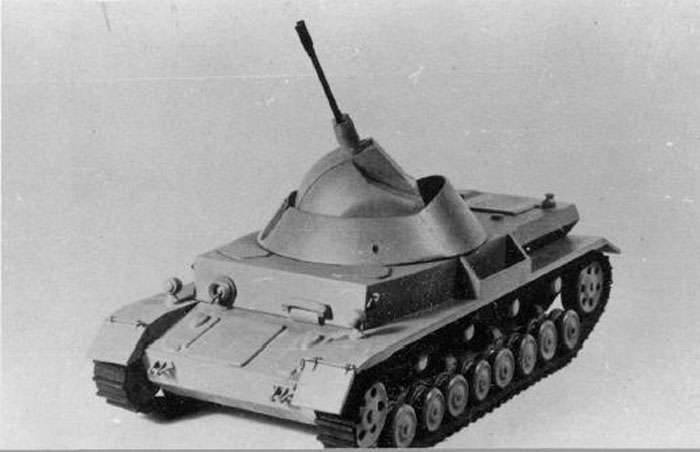
Layout ZSU Flakpanzer IV Kugelblitz. Photo Aviarmor.net
The next project of developing self-propelled guns with anti-aircraft weapons started at the very end of 1943. The creation of a new machine was commissioned to Rheinmetall and Daimler-Benz. By the middle of spring 44, an approximate image of the new ZSU was formed. To simplify the production of new technology, it was again proposed to use ready-made components. The basis for the "ball lightning" was to be the chassis of the tank Pz.Kpfw.IV one of the later modifications (specially collected or borrowed from the finished combat vehicle). As a combat module, it was proposed to take the special MK 303 Doppelflak turret, developed by Rheinmetall for installation on submarines of type XXI, as a replacement for existing artillery installations.
In April, 1944, such a project was approved by the customer, which allowed to complete the development and proceed with the construction of the first prototype. Exact data on some further work is missing. According to one source, the project was faced with a shortage of necessary components, which led to its processing. Other sources talk about the construction of the first prototype of the original project, the identification of a number of technical problems and subsequent processing. Anyway, by the beginning of the fall of 1944, the Kugelblitz project was noticeably reworked. Changes undergone as a tower with weapons, and the base chassis.
In previous projects it was proposed to use ready-made tank chassis with minimal modifications. The tower was removed from the corps, and all the aggregates of the original tank combat compartment were removed from its internal volumes. It was proposed to install a platform with a wheelhouse and armament, or a new turret with the possibility of rotation on the vacated space. Similarly, it was planned to build a new ZSU, but in this case it was necessary to make adjustments to the hull design.
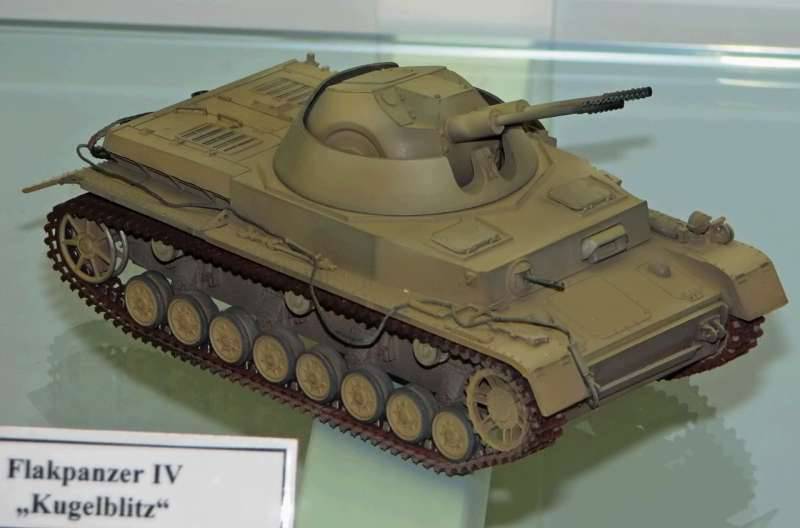
Modern mock self-propelled model. The original construction of the tower is clearly visible. Photo of Wikimedia Commons
The new tower with two small-caliber guns in its dimensions was significantly different from other similar units, because of which its installation on the Pz.Kpfw.IV in the original version was not possible. To do this, the authors of the project had to redo the hull roof and equip it with a new shoulder strap for towers with a diameter of 1,9 m, borrowed from a heavy tank Pz.Kpfw.VI Tiger. In addition, inside the case, on the site of the old fighting compartment, it was necessary to place a set of new equipment, laying for ammunition, etc.
With the exception of the chassis roof, the chassis should have remained the same. Late modifications of the Pz.Kpfw.IV tank were considered as a potential base for the “Fireball”. In practice, the construction of such machines used only the Ausf.H modification chassis, which by that time formed the basis of the fleet of medium tanks and was produced in large quantities. In this case, as far as is known, the prototypes of Flakpanzer IV Kugelblitz were built only by reworking existing machines that came for repairs.
The medium tank Panzerkampfwagen IV Ausf.H was a further development of earlier ideas, but differed from the previous modifications in a number of characteristics, primarily enhanced protection. Thus, the frontal hull sheet had a thickness of 80 mm and accordingly increased the overall level of protection of the crew and internal units in comparison with tanks of previous modifications. Despite the use of thicker armor, other features of the tank remained the same. In particular, the layout remained unchanged: the front location of the transmission and the fighting compartment, the central combat compartment and the engine compartment in the stern.
In the Ausf.H modification, the tank was equipped with a Maybach HL 120TRM gasoline engine with an HP 300 power. With the help of a cardan shaft, passing under the floor of the fighting compartment, torque was transmitted to the mechanical transmission of the front location. The main clutch, six-speed gearbox and a number of other units ensured the rotation of the front drive wheels.
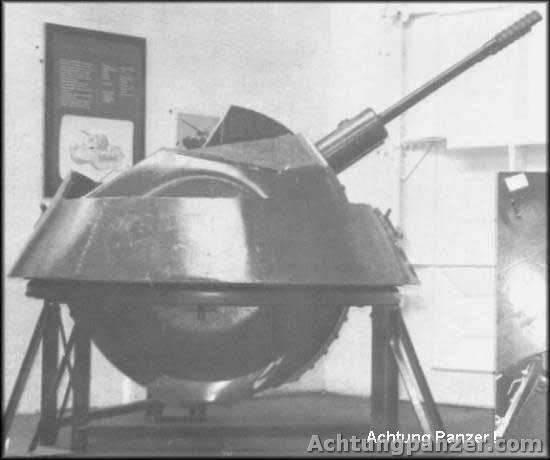
One of the towers that survived to the end of the war. Photo by Achtungpanzer.com
As part of the crawler propulsion unit, there were eight track rollers on board, interlocked in pairs and mounted on a spring suspension. A characteristic feature of the chassis of the Pz.Kpfw.IV modification “H” was the presence of support rollers without rubber elements.
The project Kugelblitz implied the use of a new tower of the original design. It was originally proposed to use an existing combat module designed for new submarines. However, by the time this project was ready, it was found that the mass construction of such equipment was virtually impossible. The production of automatic guns MK 303 could not provide the necessary products and submarines, and anti-aircraft self-propelled guns. For this reason, the developers of "ball lightning" had to look for a new weaponand then finish the finished tower.
In the final form, the combat module of the perspective ZSU was an aggregate, which with certain reservations can be considered a swinging tower. The fact is that the tower originally developed for submarines had to not only fire in any direction, but also withstand the pressure of seawater. In this regard, the original design was developed, consisting of two main parts. After some changes, such a tower could be mounted on an existing tracked chassis. Despite the improvements, the overall architecture of the product remained the same.
The tower of a new design consisted of two main parts. The first - a cone-shaped block, based on the hull shoulder strap. With it, the entire tower had to rotate around a vertical axis and carry out horizontal guidance. In the frontal part of the conical part, two vertical cutouts were provided, which, when fired with minimal angles of elevation, should have included gun covers. In the stern, the height of the part was increased to slightly improve the defense of the tower. On the sides in the lower part of the tower there were two holes for mounting the axis of the indoor unit.
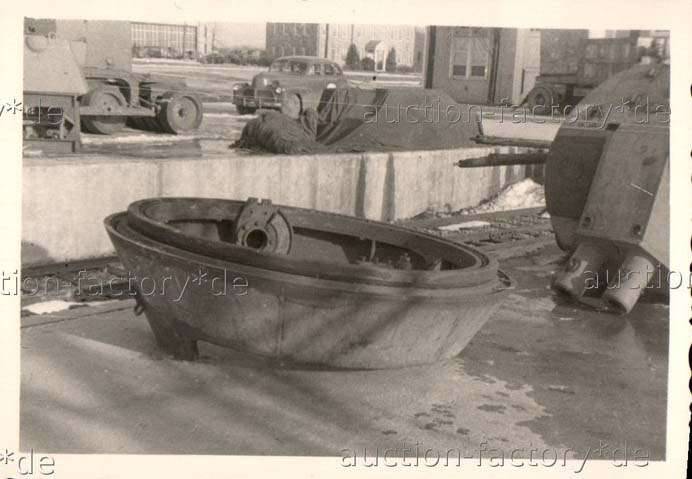
Trophies at one of the plants. In the foreground, the lower conical part of the tower (inverted), behind - the internal unit. Photo Forum.valka.cz
The second element of the tower was a swinging unit of complex shape. Its frontal sheet was made in the form of a cylinder section with a horizontal axis. The sides had a spherical shape with straightened sections in the center, on which fastenings were located for installation in the rotating part of the tower. The upper part of the rocking unit had a central frontal protrusion with two short cylindrical casings to accommodate guns, on the sides of which there were notches with hatches for observing and using sights. The rear of the roof was straight and sloping slightly backwards. The internal assembly of the tower had only the front part of the bottom, and the opening at the rear part provided access inside the case.
When assembling, the internal assembly of the tower was proposed to be installed on the external axles with the possibility of swinging in a vertical plane. Thus, for horizontal guidance, it was necessary to turn the main conical block, setting in motion the entire tower, and it was proposed to carry out vertical guidance by swinging the internal device. To control such guidance systems it was proposed to use hand drives. According to some reports, also provided hydraulics. All parts of the armor tower had a thickness of 20 mm. Due to the overlap between the parts of the external and internal units in the lower part of the tower, a kind of exploded armor was formed. The total weight of the turret with the armament assembly was 3,5 t.
In view of the impossibility of using cannons, envisaged by the original project, the developers of the Kuzloblitz ZSU decided to use other weapons. As the main weapon of self-propelled guns were proposed two automatic guns MK 103 caliber 30 mm, originally created for the aircraft. These guns should be mounted in the frontal part of the tower and equipped with belt feeding systems for the possibility of long-term continuous shooting. Interestingly, the proposal to use 30-mm guns MK 303 or MK 103 was a reasonable compromise between the various weapons. Two guns caliber 30 mm allowed to increase firepower in comparison with the 20-mm systems, including the quad, and also exceed the rate of fire guns caliber 37 mm.
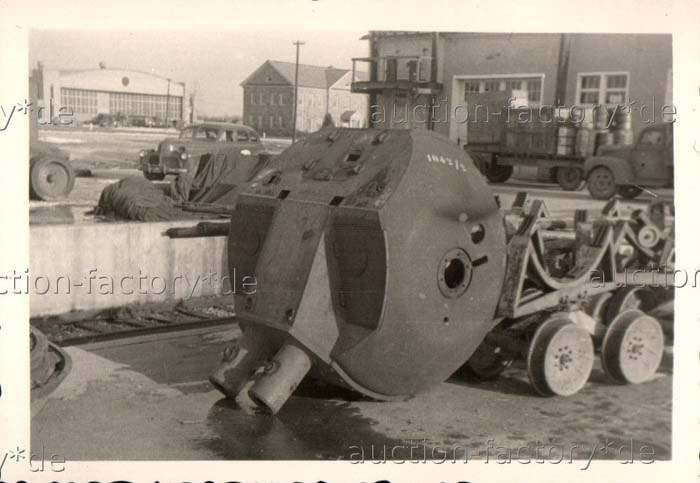
The internal assembly of the tower without weapons and equipment. You can consider its shape. Photo Aviarmor.net
The MK 103 gun was equipped with a barrel of 45 caliber length and had automatic based on a combination of gas exhaust and recoil barrel. Its ammunition could include 30x183 mm B shells of various types, primarily high-explosive and armor-piercing shells. There is information about the use of enhanced projectiles of increased power. The gun’s rate of fire depended on the type of ammunition used. Thus, using armor-piercing shells, it was possible to make up to 420 rounds per minute, while high-explosive fragmentation provided only 380. The maximum velocity of the projectile reached 940 m / s. Ammunition was supplied from special boxes using metal ribbons. The design of the gun mount allowed to simultaneously fire from two guns or shoot only from one.
In the packing of the fighting compartment it was planned to carry several tapes with shells. The total ammunition of two guns, according to various sources, reached 1000 projectiles - according to 500 per gun. At the rate of firing of the order of 400 rounds per minute, the ammunition (in the amount up to 800 rounds per minute) of portable ammunition was enough for no more than 70-90 from continuous fire. It was assumed that in a combat situation "Ball Lightning" will work together with the carriers of ammunition and receive additional ammunition from them.
As an additional weapon, the MG34 machine gun and the MP38 / 40 submachine gun were offered. The first was mounted in the frontal installation of the case, and the second should be stored in the installation and used only when necessary.
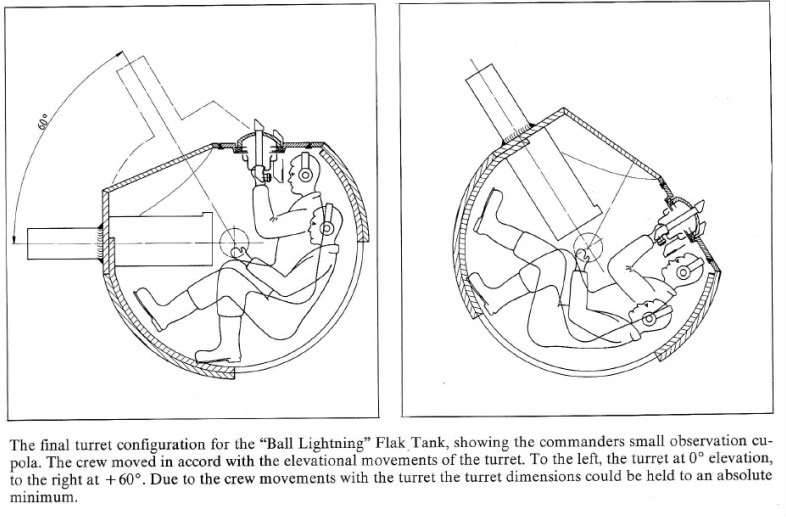
The placement of the gunner inside the rocking part of the tower. Figure Forum.warthunder.com
The crew of the ZSU Flakpanzer IV Kugelblitz was to consist of five people. The driver and radio operator were located in the front compartment of the hull. The places of the commander, gunner and loader were in the tower. The gunner and the loader were to sit on the sides of the cannons, and the commander's place was in the stern of the tower. Due to the limitations imposed by the design of the tower, the crew had a specific set of hatches. Despite the installation of a new shoulder strap, the hull had to keep two hatches for the radio operator and driver. In the tower, in turn, there was only one hatch with a double cover. It was assumed that at first the gunner and the loader would get into the fighting compartment, and the commander would have to be the last to get into the car. Accordingly, the commander was the first to leave the fighting compartment.
As a means for observation, it was proposed to use two inclined frontal sheets of the swinging part of the tower, which were manhole covers. They were installed pivotally and could fold up to the central casing of the guns. In a combat situation, these hatches should be closed and observed through small round hatches with movable covers. The design of hatches and hatches provided observation of the terrain and allowed the use of existing sights. In the left casement cover of the single hatch of the tower was located commander periscopic device for monitoring the terrain and air situation.
According to calculations, the combat mass of the Kugelblitz ZSU should have been 23 T. The dimensions remained at the base tank level: length is about 5,9 m, width is 2,95 m and height is 2,4 m. It should be noted that due to the use of the original tower, the anti-aircraft self-propelled gun was almost The 300 mm is lower than the base tank, although it was based on a similar chassis. However, the lower height of the tower and its more dense layout adversely affected the volume of the crew compartment, and also led to a reduction in the ammunition load and deterioration of the working conditions of the crew.
At the beginning of autumn 1944, the development of the project was completed, after which the assembly of the first prototype of the advanced ZSU began. As a basis for this machine, the combat tank Pz.Kpfw.IV Aufs.H, which arrived in the rear for repair, was taken. The tank lost its turret and received a modernized roof with a larger shoulder strap, and was also equipped with a new fighting compartment with the original turret. The assembly of the experienced "Ball Lightning" was completed in November and soon the car entered the testing ground for testing.
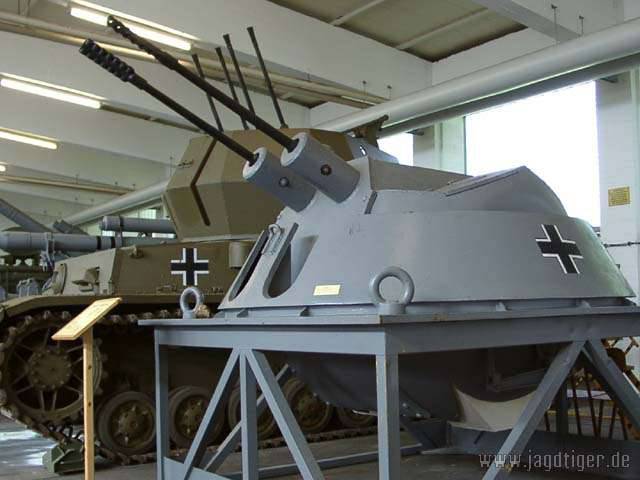
The only preserved tower stored in the museum. Photo Forum.valka.cz
Checks showed that the use of the new turret did not affect the mobility of the armored vehicle. The maximum speed remained at the level of 38-40 km / h, the power reserve - 200 km. Thus, in terms of running characteristics, the self-propelled gun was no different from the base tank Pz.Kpfw.IV. There is also the possibility of moving over rough terrain and overcoming various obstacles. The tower also showed its best. The applied weapons and guidance systems ensured the attack of various air and ground targets at distances up to 5-5,7 km, and the firing rate made it possible to count on a greater probability of hitting enemy vehicles.
After some trials, already in November of 44, it was decided to start mass production of new equipment. The Flakpanzer IV Kugelblitz self-propelled guns were to be built at the Daimler-Benz and Stahlindustrie plants. Production should start with five cars in November, and from December to go on pace in 30 machines per month. Nevertheless, the advancement of the anti-Hitler coalition troops and the general problems at the front did not allow for the launch of a full-fledged production of new equipment, if it concerned the reduction of the output of other existing types of machines. As a result, this adversely affected the construction of new ZSU.
According to various sources, no more than a new type of self-propelled 3-5 self-propelled guns were built. This technique was given to one of the army training units. In addition, it is known about the assembly of several towers that were never installed on the chassis and were used independently. After the completion of the assembly of these products, all the work on the construction of new self-propelled guns stopped. Plans for the production of three dozen cars per month could not be implemented in principle.
Initially, the Kugelblitz self-propelled gun was intended primarily for use on the Western Front, where air strikes dealt particularly tangible damage. Nevertheless, all built vehicles of this type, as far as is known, fought on the Eastern Front. In view of the late appearance, the new technique had time only for the final battles of the Second World War. According to some reports, part of the towers without a chassis, as well as at least one full-fledged ZSU took part in the defense of Berlin, but were destroyed by the advancing Red Army. The fate of the remaining products is unknown. Apparently, all finished armored vehicles were destroyed in battles in other sectors of the front.
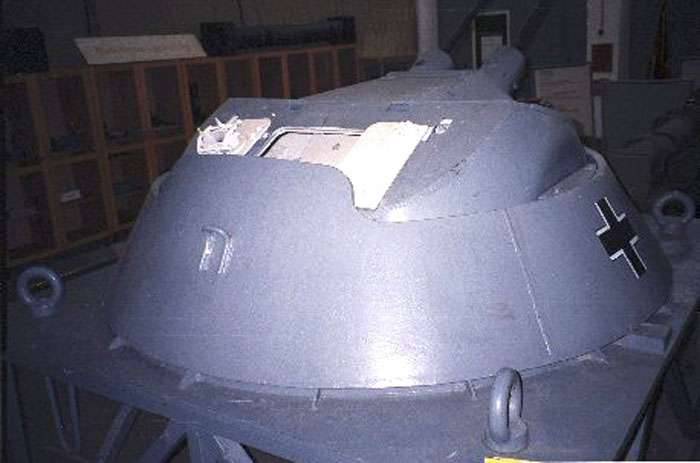
The roof of the museum tower, the only hatch is open. Photo Panzerbaer.de
Towers without a chassis were a bit luckier. One such product became the trophy of the Allies and was later transferred to the museum in Rendsburg. In addition, in the mid-nineties, on the site of the Second World War, the remains of another tower for the Fireball were discovered. Soon, the found units were sent for restoration, after which they also became a museum exhibit.
Based on the original Flakpanzer IV Kugelblitz anti-aircraft self-propelled gun, it was planned to create several new machines of similar purpose. Thus, a turret version was developed with two 30-mm cannons and two additional 20-mm caliber guns. Such weapons were proposed to be used for some ammunition savings. For relatively weak targets, the 20-mm guns should have been used. In addition, they were intended for pre-shooting: the final defeat of the target in this case was proposed to be carried out with the help of 30-mm guns. This version of the tower for ZSU remained on paper.
At the end of autumn 1944, the German industry management decided to curtail the production of Pz.Kpfw.IV tanks in the middle of next year. For this reason, the Kugelblitz self-propelled guns needed a new chassis. Considered options for mounting the tower with 30-mm guns on the chassis of a light tank Pz.Kpfw.38 (t) and medium Pz.Kpfw.V Panther. Such proposals were worked out, but were not implemented due to the deterioration of the situation on the fronts. Moreover, by the time of the anticipated start of production of such equipment, Nazi Germany was defeated.
The proposal to build anti-aircraft self-propelled guns on the basis of a massive medium tank Panzerkampfwagen IV made sense and promised a lot of advantages. However, due to the mass of technical and administrative difficulties, it was not fully implemented and with the expected result. As a result, the total number of all four models of the ZSU of the Flakpanzer IV family barely overcame a threshold of four hundred. For effective protection of troops from an air attack, this was too little. As a result, the long-term project did not produce tangible results and in fact ended only with a dubious waste of time and resources, bringing the end of the war closer.
On the materials of the sites:
http://achtungpanzer.com/
http://aviarmor.net/
http://alternathistory.com/
http://militaryfactory.com/
http://panzerbaer.de/
http://forum.valka.cz/
Information